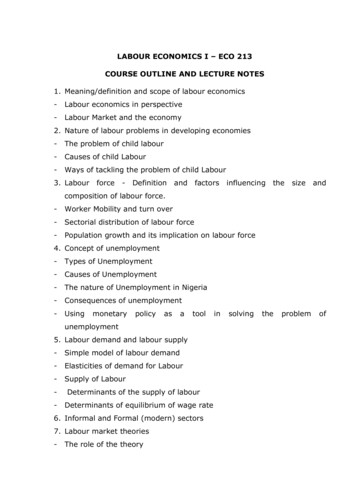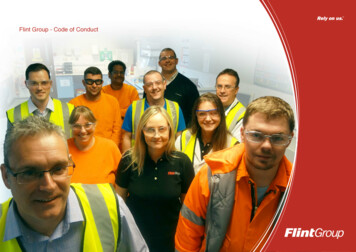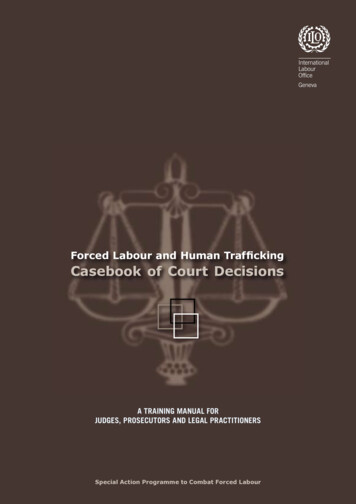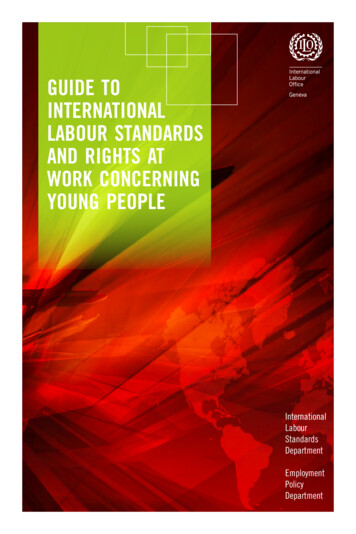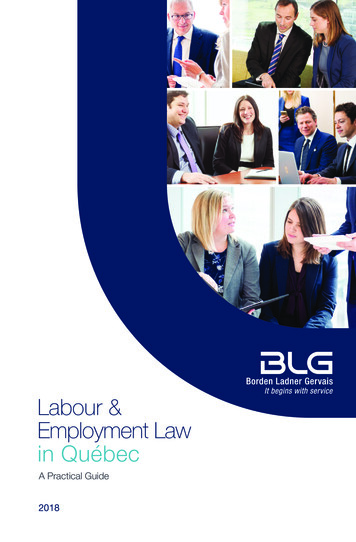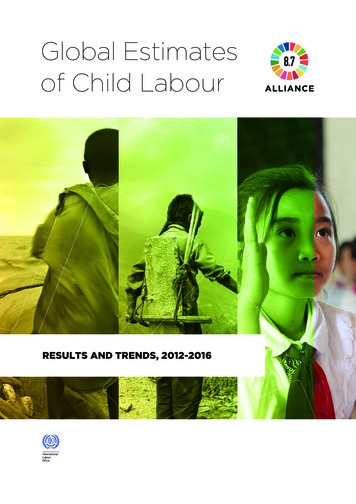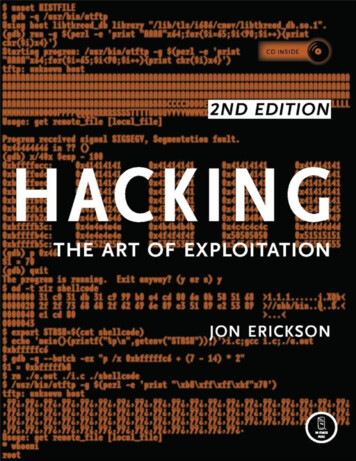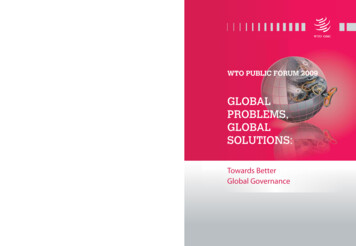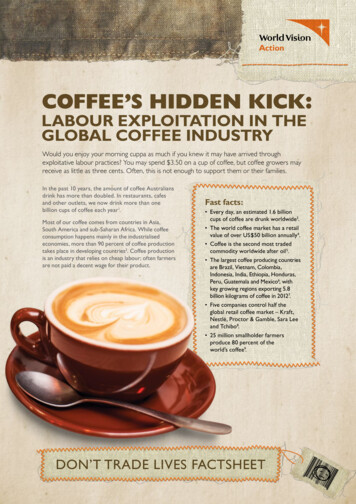
Transcription
COFFEE’S HIDDEN KICK:LABOUR EXPLOITATION IN THEGLOBAL COFFEE INDUSTRYWould you enjoy your morning cuppa as much if you knew it may have arrived throughexploitative labour practices? You may spend 3.50 on a cup of coffee, but coffee growers mayreceive as little as three cents. Often, this is not enough to support them or their families.In the past 10 years, the amount of coffee Australiansdrink has more than doubled. In restaurants, cafesand other outlets, we now drink more than onebillion cups of coffee each year1.Most of our coffee comes from countries in Asia,South America and sub-Saharan Africa. While coffeeconsumption happens mainly in the industrialisedeconomies, more than 90 percent of coffee productiontakes place in developing countries2. Coffee productionis an industry that relies on cheap labour; often farmersare not paid a decent wage for their product.Fast facts: Every day, an estimated 1.6 billioncups of coffee are drunk worldwide3. The world coffee market has a retailvalue of over US 50 billion annually4. Coffee is the second most tradedcommodity worldwide after oil 5. The largest coffee producing countriesare Brazil, Vietnam, Colombia,Indonesia, India, Ethiopia, Honduras,Peru, Guatemala and Mexico6, withkey growing regions exporting 5.8billion kilograms of coffee in 20127. Five companies control half theglobal retail coffee market – Kraft,Nestlé, Proctor & Gamble, Sara Leeand Tchibo 8. 25 million smallholder farmersproduce 80 percent of theworld’s coffee9.DON’T TRADE LIVES FACTSHEET
Did you know?This year, Australians will spend almost 800 million on coffees10. Australia’s coffeeindustry is currently worth 5 billion. By2016, it will be worth 6.55 billion11.COFFEE AND EXPLOITATION:A HOT TOPICCoffee farmers often live in poor ruralcommunities that rely on coffee harvesting astheir primary source of income. They are mainlysmallholder farmers, who have a small plot of landto grow their crop.Coffee farmers receive 7-10 percent of the retailprice of coffee sold in supermarkets12. When pricesfall below the costs of production, farmers maystruggle to feed their families and pay medical billsand school fees. Often they are forced to keeptheir children out of school to contribute to thefamily income, by working on the farm or as acasual labourer13.Growing and harvesting coffee involveslabour-intensive manual work, such as picking,sorting, pruning, weeding, spraying, fertilisingand transporting.Factors outside of a farmer’s control – such asglobal commodity prices, free market economicpolicies, adverse weather and shifting market shares– may cause global coffee prices to fluctuate. If theglobal market and international coffee companiespush for a lower price, coffee farmers may earn aslittle as 1-3 percent of the retail price14.Lack of price stability for coffee can lead tosituations of labour exploitation, where workersand their families have little choice but to workin exploitative or dangerous conditions to earna small income.Child labourChild labour has commonly been noted in theglobal coffee industry15. In Guatemala, coffeepickers may be required to pick a daily quotaof 45 kilograms in order to earn the minimumwage16. To meet this quota, many coffee workersbring their children along to help.These child workers are not officially employedand therefore do not receive labour protections17.This keeps children out of school and exposes themto the hazards of labouring at a young age. Childlabour is often the only way families can make endsmeet, because the adults are not paid a decent wage.Like their parents, children may be exposed tohazardous working conditions – they work inintense heat, are required to carry heavy loads, andwork with sharp tools and pesticides18.Children and their parents often endure poor livingconditions in crowded, temporary accommodation,sometimes with no drinking water or electricity.Working hours are commonly in excess of legallimits, and the families earn far less than theminimum wage19.WHAT IS CHILD LABOUR?Child labour is any kind of work that deprivesa child of their childhood, their potential andtheir dignity. It is work that exceeds aminimum number of hours and that is harmfulto a child’s physical and mental development.It may include work that is mentally, physically,socially or morally dangerous and work thatinterferes with schooling.
WHAT IS FORCED LABOUR?Forced labourForced labour is when a person is forced orthreatened into providing labour or services and isnot free to stop. It often occurs when employerstake advantage of vulnerable people, such as thoseaffected by poverty, high rates of unemployment,discrimination, corruption, political conflict, or lackof education or knowledge of their rights. Migrantsare particularly vulnerable, but individuals may alsobe forced into labour in their own countries.Forced labour has been reported in thecoffee growing regions of Guatemala and theCote d’Ivoire20. Workers may suffer verbalor physical abuse and threats of loss ofwork, wages or food, if they do not performto a certain – often unrealistic – standard.They may be subjected to hazardous workconditions and be denied a contract ofwork, regular payment, protective clothingor proper medical care. Their identificationpapers may be confiscated, which keepsthem trapped in that location.WHERE DOESEXPLOITATION OCCUR?2197536104112141281131.2.3.4.ColombiaCôte d’IvoireDominican RepublicEl Salvador5.6.7.8.GuatemalaGuineaHondurasKenya9. Mexico10. Nicaragua11. Panama12. Sierra Leone13. Tanzania14. Uganda
HOW DOES YOUR COFFEEGET TO YOU?Coffee farmersplant, graft, cutbranches, harvest, fertilise and fumigate usingchemicals and pesticides22. Farmers may notbe paid a fair wage for their product andhave to endure poor working conditions.Forced and child labour has been reportedin coffee growing.Buyerspurchase coffee fromfarmers to sell to larger markets.The price paid differs from farm tofarm and country to country.Processorshull, sort and grade thequality of beans. Child labour may be usedto process beans and prepare them forexport. Beans are then sold to exportersin different markets23.Exporters buy processed beansand sell them to multiple brokers aroundthe world.Brokersbuycertain types of beanto sell to importers.Importers sell beans to distributors at profit.Distributorsbuy beans to distributeat profit to selectedretailers – shops, cafesand restaurants.Retailerssell productsto the public at profit.NOTE: The coffee supply chain can differ from company to company. In some cases, companies have oversight over severalstages of the process. Other companies outsource these different stages to external partners.
WHAT ETHICAL COFFEEMEANS FOR FAMILIESFive years ago, 40-year-old Tesfaye was strugglingto provide for his wife Marta and their children.Despite living in the Kochore district of southernEthiopia, one of the best coffee growing places inthe world, Tesfaye and other coffee farmers foundit almost impossible to make ends meet.“I did not have anything,” Tesfaye said. “I wasnominated from my kebele [local administration] toparticipate in trainings given by World Vision.”Since then, World Vision has supported Tesfayeand other coffee farmers in his community throughtraining and development programs, and therevitalisation of their coffee growing cooperative.Through these efforts, local coffee farmers havebeen able to increase the income they receive fromthe sale of their coffee.“I got trained on coffee growing and management.I applied all the trainings I gained and now I haveeverything,” said Tesfaye.Tesfaye and his wife Marta have nine children,four girls and five boys. Seven of them are goingto school. The remaining two are still too youngto attend, but Tesfaye feels secure that he is nowearning enough money to keep them all in school,and to continue to fund after-school classes.“I have my own house very well furnished threehectares of coffee [and] about two hectares of falsebanana [a staple food item in the area]. I have over10 oxen, which I have given to different farmers forfattening. I have cows,” said Tesfaye.The ability to diversify income is often importantin coffee growing regions, so that families are notreliant on one commodity. This means that they areprotected if this crop doesn’t grow well in harshweather conditions.Tesfaye receives added security because the farmingcooperative works with Fairtrade, the ethicalcertification scheme that guarantees a better priceand conditions for coffee farmers. This scheme alsoprovides consumers with assurance against the useof forced or child labour in a product.International coffee suppliers that purchase fromFairtrade-certified farms are entitled to put the logoon their product. This helps consumers see thatthe company is taking significant steps to eradicatelabour exploitation in the supply of that product.World Vision has helped increase theincome of Tesfaye and other coffeefarmers in Kochere through fair trade.NOTE: xxxxPhoto: Fasil Damte/World Vision
WHAT IS BEING DONE?It has been widely acknowledged that theglobal coffee industry has relied upon exploitativelabour practices, human rights abuses andeconomic injustices24, 25.A combined effort has seen conditions in certainplaces improve. The work of non-governmentalorganisations (NGOs), businesses, sustainableindustry initiatives, and the increasing demands ofconsumers that their coffee is produced ethicallyhave all helped. However, there is still more workto be done.The fair trade movementIncreasingly, there has been a focus on a fairtrade market-based approach to promote bettertrading conditions and sustainability for farmersand producers in developing countries. The fairtrade movement aims to improve labour andenvironmental standards, and educate workers toimprove their skills, products and subsequentlyprofit – through both practical interventions andinternational policy reform.Amongst other things, farmers receive a higherprice for their coffee than the average market priceand work in better conditions that prohibit the useof exploitative labour practices.Ethical certification provides independent thirdparty auditing of supply chains, to ensure standardsare being upheld. Ethically certified coffee hasrisen in popularity as more consumers recognisethat this standard means fair trade principles areupheld throughout the production of that coffee.Increasingly, companies are also recognising thevalue of certification through schemes such asFairtrade International 26, Rainforest Alliance27 andUTZ Certified 28.Many companies have implemented programs toimprove their sustainable sourcing practices. Whilstsome opt for ethical certification schemes, otherschoose to do this independently. This can also be areasonable solution, as long as they are transparentin providing an independent audit of their work andprogress, and make a timetabled commitment toethical sourcing across their entire coffee range.Civil societyGlobal civil society organisations have implementedvarious programs to help improve conditions andlivelihoods for farming communities. These include: programs to improve farmers’ access to marketsto sell their products; the organisation of cooperatives so smallscalefarmers can compete with bigger landholders; supporting communities to work with ethicalcertification schemes; and education about child labour and the importanceof balancing schooling with work.A fair trade coffee pulping plant in Kochere, where local coffee is processed for export.Photo: Fasil Damte/World Vision
WHAT CAN I DO?Use your purchasing power to ensure the coffee you drink is made ethically!Think before you drinkGive your custom to the brands, shops, supermarkets, cafes and restaurants that take stepsto ensure their products are not tainted by labour exploitation. Look for ethically certifiedproducts: it’s a good start! Use Shop Ethical! 29 to help you find better brands. You can also askyour local supermarket or favourite coffee shop to stock ethically sourced coffee.Write to companiesIf it’s not clear what coffee companies are doing to ensure better conditions for coffee farmers –ask them to tell you: when 100 percent of their coffee will be ethically sourced; whether their coffee is independently verified to have been made without the use of forced,child and trafficked labour; if they transparently report on their progress towards ethical sourcing, and their investmentin and progress of initiatives to directly address labour exploitation; and if they don’t, tell themthey should!Get others involvedAsk your workplace, school, church and local shops and cafés to switch to ethically sourcedcoffee. Share this fact sheet with your friends and family and encourage them to do the same.Ethically certified coffee is a great choice.
For more informationvisit worldvision.com.au/act1. Australian Coffee Traders Association (ACTA). Accessed on 3 October 2013.Available from: http://www.acta.org.au/article.php?a 22. World Development (Elsevier Science Ltd) (2002) “The ‘Latte Revolution’?Regulation, Markets and Consumption in the Global Coffee Chain”. Availablefrom: http://my.ewb.ca/site obal%20coffee%20chain.pdf3. Fairtrade UK (May 2012) “Fair trade and Coffee: Commodity briefing.Available from: ocs/2012/F/FT Coffee Report May2012.pdf4. The Australian (13 September 2008) “Coffee consumers become moresophisticated”. Accessed on 03 October 2013. Available from: 1111174679435, 21, 22, 23, 25. Verite Commodity Atlas (2013). Accessed on 3 October 2013.Available from: http://www.verite.org/Commodities/Coffee6. Bloomberg (29 November 2011) “World’s top 10 coffee producing countries”(2010-2011) Accessed on 3 October 2013. Available from: -.html7. Australian Association of Convenience Stores (29 November 2011) “Coffeeis a liquid lifeline for Australia’s cafe industry”. Accessed on 3 October 2013.Available from: -for-australiascafe-industry/8. Figures reported by sources vary. The World Bank notes that the four largestroasters control 45 percent of the market; World development report 2008,2007, p. 136. Available from: http://hdr.undp.org/en/media/HDR 20072008EN Complete.pdf9. Fairtrade UK (May 2012) “Fair trade and Coffee: Commodity briefing.Available from: ocs/2012/F/FT Coffee Report May2012.pdf10. Australian Food News (18 March 2011) “The Coffee Club declares SydneyAustralia’s biggest coffee drinkers”. Accessed on 3 October 2013. Availablefrom: inkers.html11. “Another cup of coffee? Yes please, say Aussies”: industry report (23November 2013). Accessed on 3 October 2013. Available from: ffee-yes-please-say-aussies-indus12, 13, 14. Fairtrade UK (May 2012) “Fair trade and Coffee: Commoditybriefing”. Available from: http://www.fairtrade.org.uk/includes/documents/cm docs/2012/F/FT Coffee Report May2012.pdf15, 20, 24. US Department of Labor (2013) List of goods produced by childlabor or forced labor. Available from: f16, 17. Global Exchange (2013) FAQs. Accessed on 3 October 2013. Availablefrom: 18, 19. Verite (2012) Research on indicators of forced labor in the supply chain ofcoffee in Guatemala. Available from: in%20the%20Guatemala%20Coffee%20Sector 9.16.pdf26. More information available from Fairtrade International http://www.fairtrade.netand Fairtrade Australia http://www.fairtrade.com.au27. More information available at http://www.rainforest-alliance.org28. More information available at http://www.utzcertified.org29. Shop Ethical! is a guide for consumers to help make more ethical purchaseswhen shopping. It is available as a smartphone app or a hard copy booklet.More information available at http://www.ethical.org.au 2014 World Vision Australia. World Vision Australia ABN 28 004 778 081 is a Christian relief, development and advocacy organisation dedicated to working with children, familiesand communities to overcome poverty and injustice. Ref #7280
The fair trade movement Increasingly, there has been a focus on a fair trade market-based approach to promote better trading conditions and sustainability for farmers and producers in developing countries. The fair trade movement aims to improve labour and environmental standards, and educate workers to


